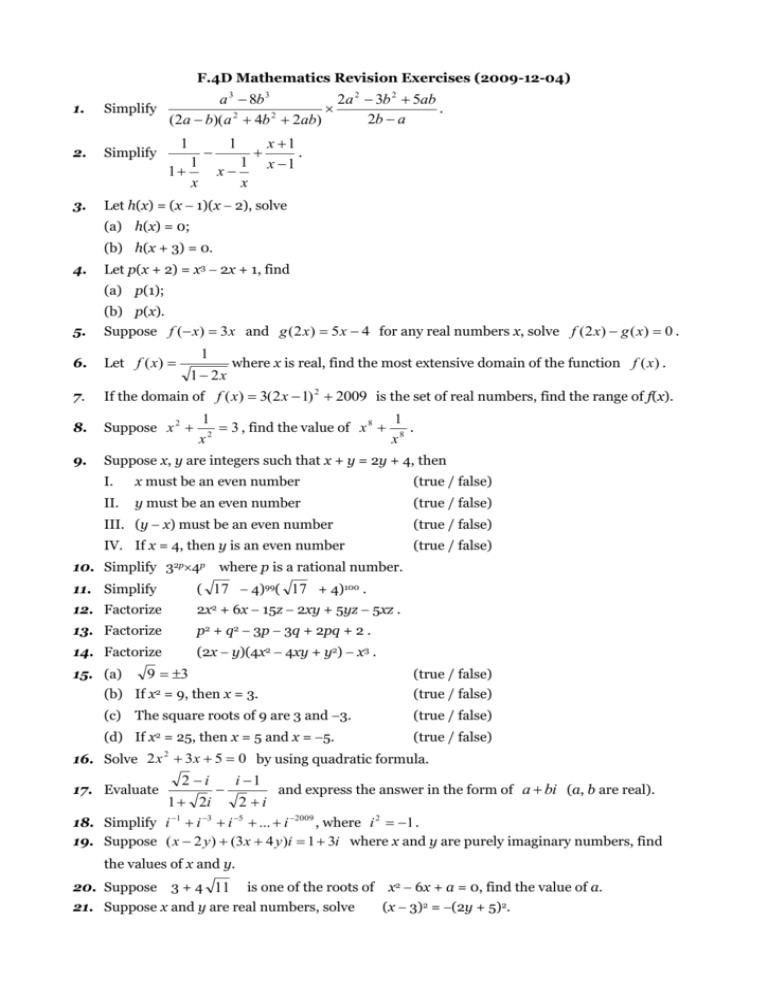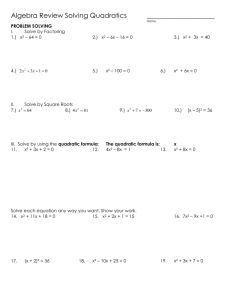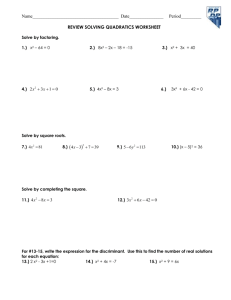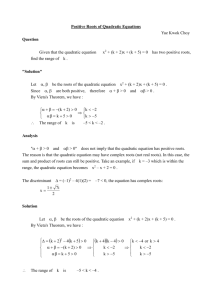F.4D Mathematics Revision Exercises (2009-12
advertisement

F.4D Mathematics Revision Exercises (2009-12-04) 1. Simplify 2. Simplify a 3 8b 3 2a 2 3b 2 5ab . 2b a (2a b)( a 2 4b 2 2ab) 1 1 3. 1 x 1 x 1 x x 1 . x 1 Let h(x) = (x 1)(x 2), solve (a) h(x) = 0; (b) h(x + 3) = 0. 4. Let p(x + 2) = x3 2x + 1, find (a) p(1); (b) p(x). 5. Suppose f ( x) 3x and g (2 x) 5 x 4 for any real numbers x, solve f (2 x) g ( x) 0 . 6. Let f ( x) 7. If the domain of f ( x) 3(2 x 1) 2 2009 is the set of real numbers, find the range of f(x). 8. Suppose x 2 9. Suppose x, y are integers such that x + y = 2y + 4, then 1 1 2x where x is real, find the most extensive domain of the function f (x ) . 1 1 3 , find the value of x 8 8 . 2 x x I. x must be an even number (true / false) II. y must be an even number (true / false) III. (y x) must be an even number (true / false) IV. If x = 4, then y is an even number (true / false) 10. Simplify 32p4p where p is a rational number. 11. Simplify ( 17 4)99( 17 + 4)100 . 12. Factorize 2x2 + 6x 15z 2xy + 5yz 5xz . 13. Factorize p2 + q2 3p 3q + 2pq + 2 . 14. Factorize (2x y)(4x2 4xy + y2) x3 . 15. (a) 9 3 (true / false) (b) If x2 = 9, then x = 3. (true / false) (c) The square roots of 9 are 3 and 3. (true / false) (d) If x2 = 25, then x = 5 and x = 5. (true / false) 16. Solve 2 x 3 x 5 0 by using quadratic formula. 2 2 i i 1 and express the answer in the form of a bi (a, b are real). 1 2i 2 i 18. Simplify i 1 i 3 i 5 ... i 2009 , where i 2 1 . 19. Suppose ( x 2 y ) (3x 4 y )i 1 3i where x and y are purely imaginary numbers, find 17. Evaluate the values of x and y. 20. Suppose 3 + 4 11 is one of the roots of x2 6x + a = 0, find the value of a. 21. Suppose x and y are real numbers, solve (x 3)2 = (2y + 5)2. 22. Let , be roots of x2 + px + 1 = 0, find a quadratic equation with roots 2 and 2. 23. Let , be roots of x2 (p + 1)x 2p = 0. Determine a quadratic equation with roots 3 , 3. 24. Suppose 3x2 + x 2 a(x + b)2 + c ; where a , b and c are constants. Find 2 3 the values of a , b and c. , are roots of x2 px + 1 = 0, construct a quadratic equation whose roots are 1 1 and . 2 2 25. Suppose 26. The following shows the graph of y = ax2 + bx + c. Fill in the blanks of the following table. a>0 b>0 c>0 4ac > b2 Yes or No? 27. The figure shows the graph of a quadratic function y = cx2 + ax b, A. a>0 (True/false) B. b>0 (True/false) C. c>0 (True/false) D. a2 + 4bc > 0 (True/false) y then y = cx2 + ax b x O 28. The figure shows the graph of y = x2 + 4x + c. Which of the following is a possible value of c? A. 4 B. 5 C. 4 D. 0 29. If 0 < p < 6, which of the following quadratic equations has / have two distinct real roots? I. (p2 + 1)x2 + (2p – 1)x + 1 = 0 II. px2 – (p + 7)x + 7 = 0 III. 1 2 x 3 px 4 p 2 18 0 2 A. I only 30. Let B. II only C. I and III only D. II and III only , be real roots of x2 + (2k 1)x = 1 k2 . If , find the range of values of k. 31. Suppose x 2 2 x 3k 1 for any real value of x, determine the range of values of k. 32. Suppose 2x2 x > 3a 10 for any real number x, find the range of values of a. 33. Which of the following may represent the graph of y = ax2 + bx + c, where ac < 0? A. B. C. D. 2 y 2 kx 18 0 34. Given that the simultaneous equations y x 3 have only one solution, find the value of k. 35. The figure shows the graphs of y = x2 – bx + c and y = –1. By considering the two graphs, which of the following simultaneous equations have two real solutions? A. y ( x 1) 2 b( x 1) c y 1 B. y ( x 1) 2 b( x 1) c y 1 C. y 1 x 2 bx c y 1 D. y 1 x 2 bx c y 1 36. How many distinct real roots are there to the equation x(x 1)(x 2) = x(x 2)(3x 5)? 37. (a) Suppose the graph of a quadratic function y = f(x) has its vertex (2,5) and y-intercept 13, find the equation of the graph. (b) Write down the coordinates of the minimum point of the graph y = |f(x)|. 38. Let y = ax2 + bx + c be the equation of a quadratic graph. Suppose the vertex of the graph is (2,1) and the y-intercept is 4. Determine the values of a, b and c. 39. The following shows a quadratic graph. Given that it passes through B(7,0) and the vertex is A(3,1). Find the equation of the graph. (5 marks) 40. (a) Evaluate the maximum value of 1 2 x 3x 7 2 (b) Determine the minimum value of . x 2 6 x 12 . x 2 6 x 14 41. Refer to the figure below. Rectangle PQRS inscribed in a right-angled triangle ABC with PQ lie on AB and R, S lie on BC and CA respectively. Given that AC = 4 m, CB = 3 m, AP = x m. C (a) Express the area of PQRS in terms of x. 4m S 3m R P Q (b) Determine the maximum area of PQRS. A [Hint: Can you figure out similar triangles?] xm B 42. Let f (t ) A(3 kt ) for any real number t. Given that when f (0) 100 and f (100) 100 . 3 Find the value of f (200) . 43. Let x = 3 2,y= 4 3,z= 5 4 . Which of the following must be true? A. x>y>z B. x>z>y C. y>x>z D. y>z>x E. z>x>y F. z>y>x 44. If 3 x 36 3 x 1 , then x 45. Solve 16 x 3(4 x ) 4 0 . 46. Solve x 2 5 x 2 6 . 47. Suppose 3 x 5 y 15 z , where x, y and z are rational numbers. Express z in terms of x and y. 48. Solve 8(4x + 4x) 6(2x + 2x) = 19 . 100 49. Simplify 1 1 k k 1 . k 10 50. Find the value of n if 51. Solve n 3 19 k 3 k 6 ak 2 a k 1 |x| = 6 x2 . 52. Solve (2x 1)2 |2x 1| 6 = 0. 53. Solve (x 1)2 + |x 1| 6 = 0. 54. Solve | x | + 2 = | x + 2 |. 55. Determine the fifth term in the expansion of (1 2 x )10 56. Find the constant term in the expansion (x2 2 9 ). x in descending powers of x. 57. Find the constant term in the expansion of 3 x 6 1 . x2 58. In the expansion of (1 6x2 + 9x4)20, find the coefficients of (a) x10; (b) x11. [Hint: 1 6x2 + 9x4 (1 3x2)2] 59. (a) Suppose (1 ax2)n 1 40x2 + 760x4 + terms involving higher powers of x. Find the values of a and n. (b) By (a), or otherwise, write down the coefficients of (i) x4; (ii) x9 in the expansion of (1 4x2 + 4x4)10. 60. In the expansion of (1 x) n , the coefficient of x 3 is equal to 7 times the coefficient of x. If n is a positive integer, find the value of n. 61. In the expansion of (1 2x)3(1 + x)n , where n is a positive integer, the coefficient of is 36 . Find the value of n . 62. (a) Find, in terms of n and r, the coefficient of xr in the expansion (2 + x)(1 3x)n; where n and r are non-negative integers (0 r n). (b) Suppose m is a square number with the coefficient of x2 in the expansion (2 + x) 1 3x m is 252, evaluate m. 63. (a) Prove by mathematical induction that 1 1 1 1 n ... 2 4 46 68 4n(n 1) 4(n 1) for any natural number n. (b) By (a) or otherwise, evaluate 1 1 1 1 1 1 1 1 ... . 2 4 2 3 4 6 3 4 6 8 4 5 200 202 101 102 64. (a) Prove that, for any positive integer n, (i) 1 1 1 1 n(n 3) . ... 1 2 3 2 3 4 3 4 5 n(n 1)( n 2) 4(n 1)( n 2) (ii) 1 1 1 1 n(n 2) ... . 1 3 5 3 5 7 5 7 9 (2n 1)( 2n 1)( 2n 3) 3(2n 1)( 2n 3) (b) Hence or otherwise, find the value of 1 1 1 1 1 ... . 1 3 5 2 4 6 3 5 7 4 6 8 2005 2007 2009 65. Let a1, a2, … be a sequence of numbers such that a1 = 1, an+1 = an + 2n for any positive integer n. Prove that an = n2 n + 1 for all positive integers n. x2 66. Prove by mathematical induction that for all positive integers n, 2 2 (1) 2 3 (2) 2 n1 (n) 2 n2 . ... 2 3! 4! (n 2)! (n 2)! 67. By using the mathematical induction, show that n3 n + 3n is divisible by 3 for any positive integer n. 68. (a) Show that 3n + 1 is divisible by 4 for any positive odd integer n. (b) Find the remainder when 3123456789 is divided by 4. 69. Prove by mathematical induction that 4 2n1 3n2 is divisible by 13 for all positive integers n. 70. (a) Show by mathematical induction that 42n + 1 + 2(7n + 1) is divisible by 9 for all natural numbers n. (b) Let x = 420001 + 2(710001) 3. Find the remainder when x is divided by 9. 71. Let f(n) = 1 1 . Prove by mathematical induction that n2 f(2)f(3)f(4)…f(n) = 1 1 (1 ) 2 n for any natural number n > 1 . 72. Prove that (3n + 1)7n 1 is divisible by 9 for any positive integer n. 73. Prove that (n + 1)(n + 2)(n + 3)…(n + n) = 2n135…(2n 1) for all positive integers n. 74. Prove, by mathematical induction, that nC1 + nC2 + … + nCn = 1 + 2 + 22 + … + 2n 1 for all positive integers n. 75. If ax2 + bx + c = 0 and bx2 + ax + c = 0 where a b and c 0, have a common root, find the value of a + b + c. 76. Suppose the quadratic equations ax 2 bx c 0 and ax 2 bx c 0 have a common root, prove that (ar cp) 2 (aq bp)(br cq) . 77. Show that the graph of y = x2 + (2 p)x + 3 1 intersects the x-axis at two 2 8 4 p 16 p 16 distinct points for any real value of p (p 2). 78. Let , be roots of x2 + px + 1 = 0, show that 4 , 4 are roots of x2 [(p2 2)2 2]x + 1 = 0. By considering the roots of x2 47x + 1 = 0, show that 4 47 2205 3 5 . 2 2 79. Find a positive integer n such that (n 3)!12! 1997!(n 1988)! . 80. Suppose (x + 1)40(9x 6 + b b b 1 40 ) (1 + 2x + x2)20 p(x) + 1 + 22 + … + 40 ; x x x x 40 where p(x) is a polynomial in x. Evaluate b37.








